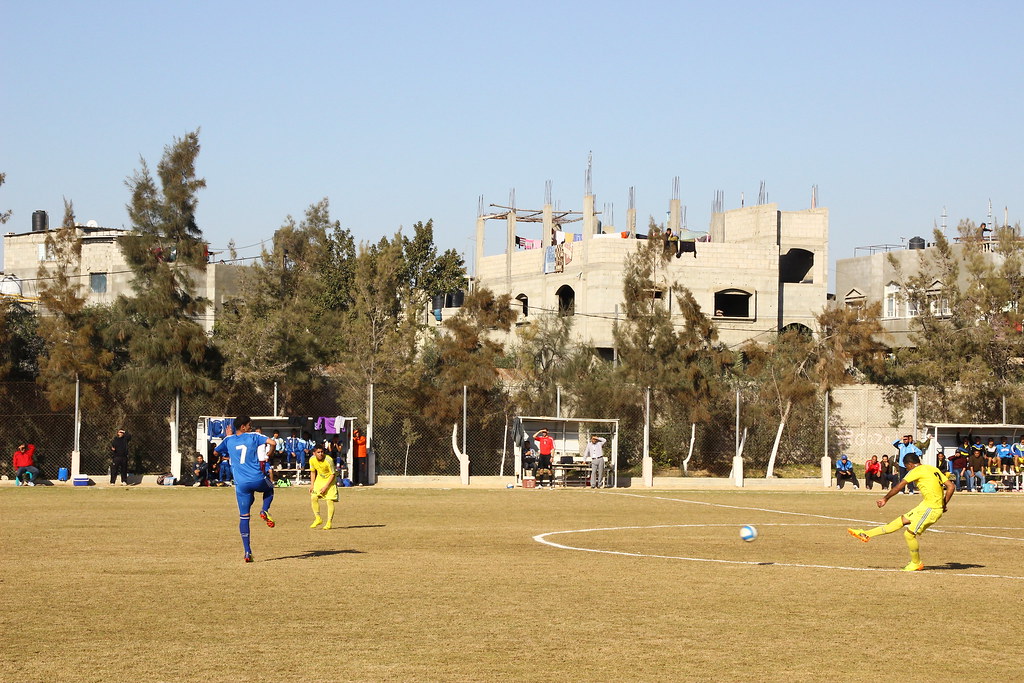by Paul Cahill
In the face of the most horrific, barbaric and public slaughter of thousands of innocent women and children in living memory an article about football in the region might be seen as belittling, trivial, irrelevant, and it is.
With all the images of death, destruction, disease, starvation and malnutrition coming out of Gaza it has become too easy to close your eyes and scroll past because the heartbreak is nearly impossible to relate to.
However, if you are reading this you are interested in football. So too are the people of Gaza and the West Bank, and Israel for that matter.
Many Palestinian people love football, and like everything else in their homeland, it has been taken from them and almost destroyed. The story of football in Palestine might resonate with fans in a way that other stories don’t. So here it is.
Palestinians are still watching football. Their dreams of qualifying for World Cup 2026 were cruelly broken with a contentious 97th minute penalty awarded against them in their recent qualifier against Oman, in Jordan ( Palestine vs Oman ).
The fact that the national team still plays, and undoubtedly are still cheered on and supported by the beleaguered population reminds us how important sport can be, as a break from all the important stuff or as a companion to all the important stuff.
Organised football in Palestine goes back to the early 20th century when the British took control of the region after the defeat of the Ottoman Empire in World War 1.
Well-practiced in colonialism at this stage the British Army established military bases throughout the region and many of these bases had football facilities for the soldiers.
Games between the different regiments and local Arab teams became common. It wasn’t long before local Palestinian clubs were forming, and football started to become popular as an organised recreational activity, even as unrest around British rule, and a rising influx of Jewish settlers increased tensions.
These early matches reflected the beginning of a football culture that was growing around the world. Football gave Palestinians something that was modern and international with a sense of national identity.
As opposition to colonial rule simmered, football evolved into more than just a game —it grew into a breeding ground of cultural nationalism and a vehicle for expressing an identity distinct from their would-be colonisers.
This might sound familiar to Irish people. Clubs like Shabab al-Arab in Haifa and Islamic Sport Club in Jaffa became community focal points, propagating a sense of national consciousness.
Similar to the G.A.A. in early 20th revolutionary Ireland, these football clubs often doubled as centres of political and cultural resistance, where young people could celebrate their heritage, language, and national aspirations in the face of increasing marginalisation by their British overlords.
There was also a rising population of Jewish settlers fleeing Nazi/Fascist Europe exerting growing influence.
The State of Israel was established in 1948, when the British handed control of the region to Zionists. The Israel Football Association (IFA) was formed by the rapidly growing Jewish population and the I.F.A. quickly integrated into the international football community.
However, the Israeli league systematically excluded Palestinian clubs and players. Many players and clubs had their movements restricted and facilities were frequently sabotaged.
While some Arab-Israeli clubs did eventually participate in the Israeli league, they often faced discrimination, underfunding, and marginalisation by governing bodies.
In spite of facing challenges that most other football associations never had to encounter, Palestinians began to build their own football infrastructure.
The Palestinian Football Association (PFA), founded originally in the 1920s, was reactivated in the 1990s. A national league system emerged in the Palestinian enclaves of the West Bank and Gaza. Clubs such as Hilal Al-Quds, Markaz Balata, and Shabab Rafah grew.
They had loyal fanbases and up to 10,000 + capacity stadiums. The league, though fragmented and frequently disrupted by political and military realities, fostered local talent and provided a sense of normality and community cohesion that only sport can.
The Palestinian National Team was also reestablished in the 1990s. Palestine was granted full membership of FIFA in 1998, marking a significant step towards international recognition.
This was a landmark moment as the world seemed to acknowledge Palestinian sporting and national identity. Since then, the national team has participated in numerous international competitions.
Recent victories against Kuwait and Iraq even brought some fleeting joy to Palestine. Despite setbacks due to ongoing conflict, military incursions, blockades, bombed stadiums, players being detained or denied travel permits, and fixtures frequently cancelled, Palestine were unbelievably still aiming to qualify for the 2026 World Cup until that 97th minute penalty decision that went against them.
Since the onset of the genocide in Gaza in 2023 football and everything else in Palestine has faced unprecedented devastation. There are no schools, no hospitals, no supermarkets, no pubs, no clubs, no streets, no roads, no holidays, no theatres, no cinemas, no tennis courts, no basketball courts, no golf courses, no football stadiums, pitches or safe places for children to play.
Following their national team however reminds me that there is still football in Palestine and it continues to offer some form of resistance, identity, and hope amongst the rubble.
The team’s history mirrors a broader Palestinian struggle, reminding the world that even in the face of genocidal erasure, football and sport in general can persist as an act of defiance and resilience.
Hopefully the national teams’ future will mirror a Palestinian recovery, success and normality that most of us have the good fortune to take for granted.
Sources of information:
https://www.theguardian.com/football/2019/aug/03/football-palestine-book-extract-nicholas-blincoe







